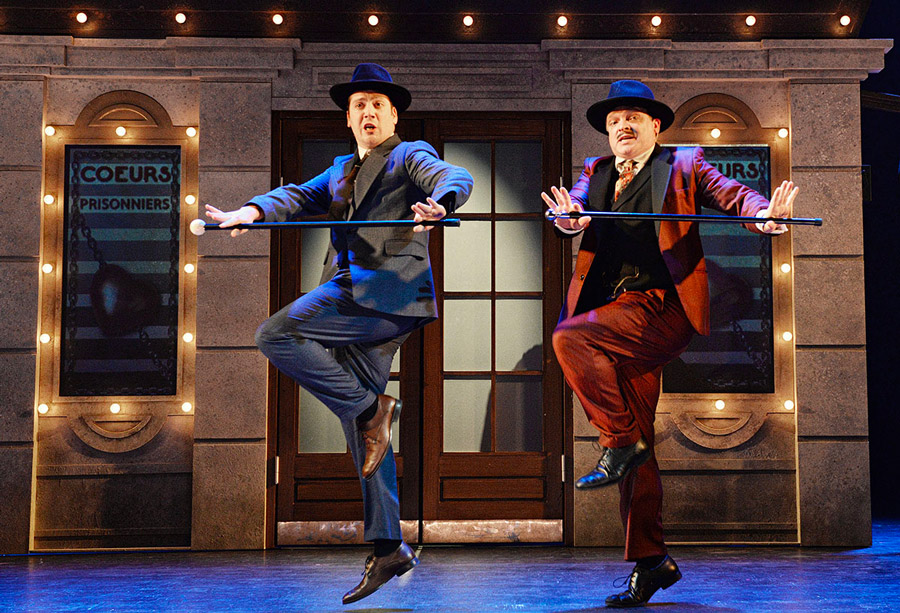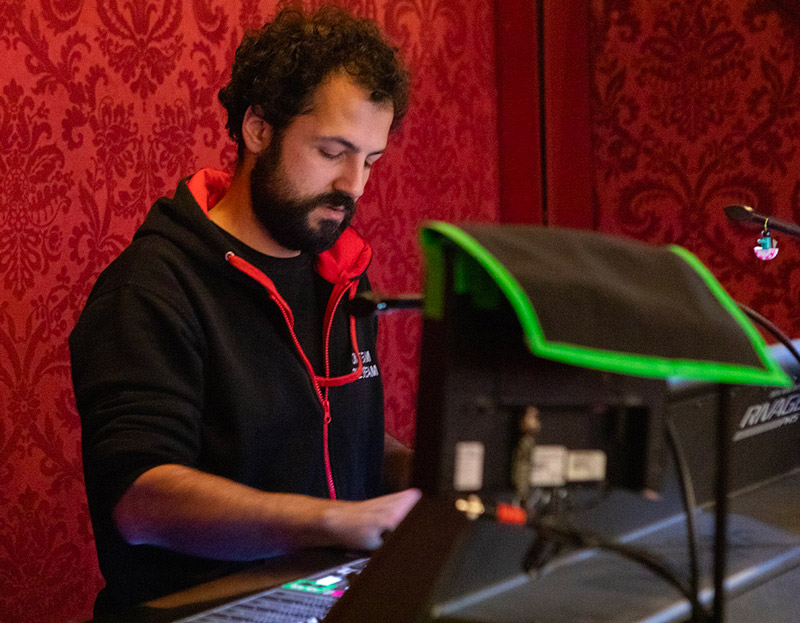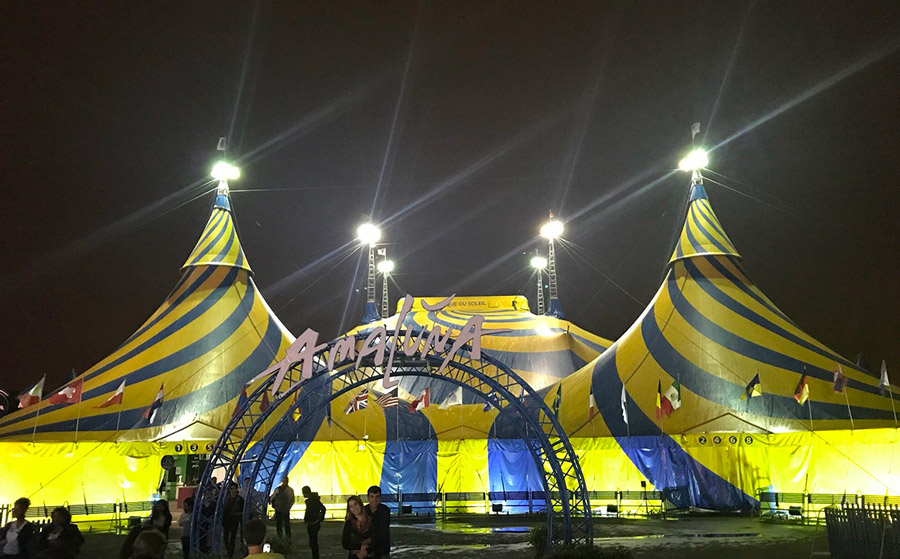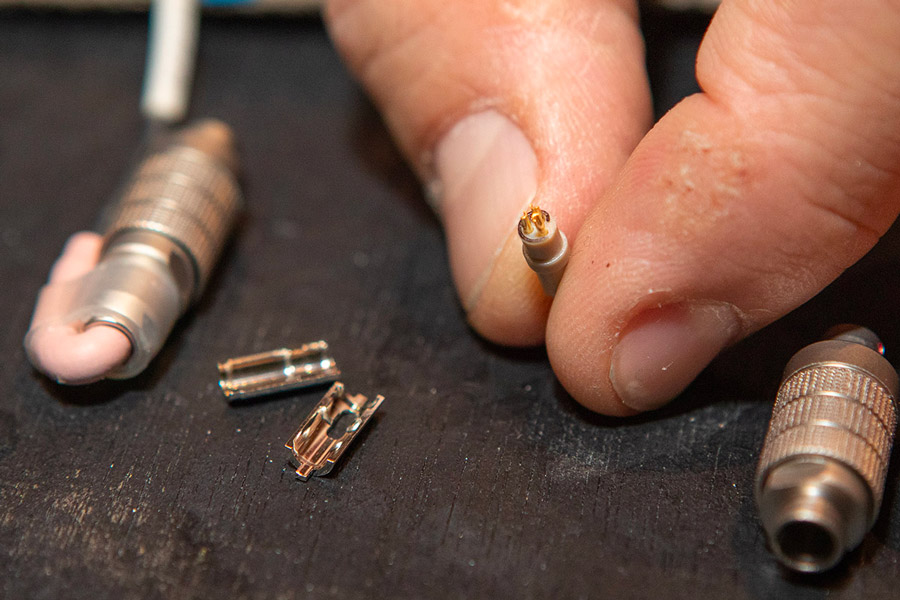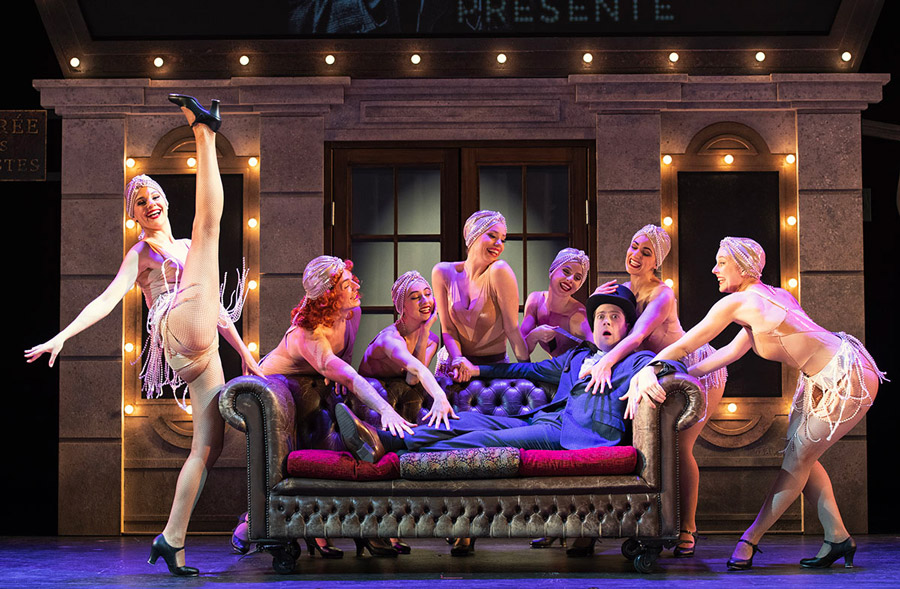If you just came across this article, please click here to go back and read the first part, otherwise, let’s get on with the music for the next and final part of our immersion in the wackiest of musicals but also in the most serious of audio installations, with Orbital for the equipment, a few delightful anecdotes from Julius and Xavier, around the world under a bigtop, as well as our listening impressions.
SLU : The venue belongs to Fimalac but it is, in a way, a facility of Stage Entertainment, which doubles the potential they have with Théâtre Mogador…
Xavier Marchand : In a way. Stage has extensive artistic and technical experience in musicals, which allowed them to stage The Producers with a great team to support the director Alexis Michalik, including Julius Tessarech who handles the sound design, considering that it is a French adaptation.
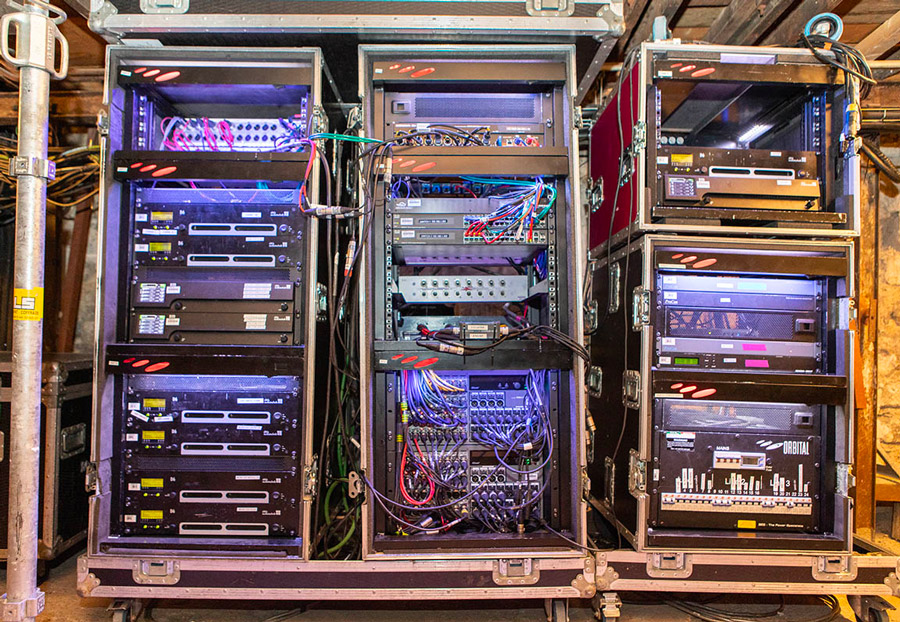
SLU : So you have teamed up with Julius…
Xavier Marchand : Exactly. The technical choices, the implementation, the specialized English vendor – all of that is his responsibility. I support the location scouting, the drawings, the equipment lists, the prediction mapping process, the adaptation to the theater, and the mix.
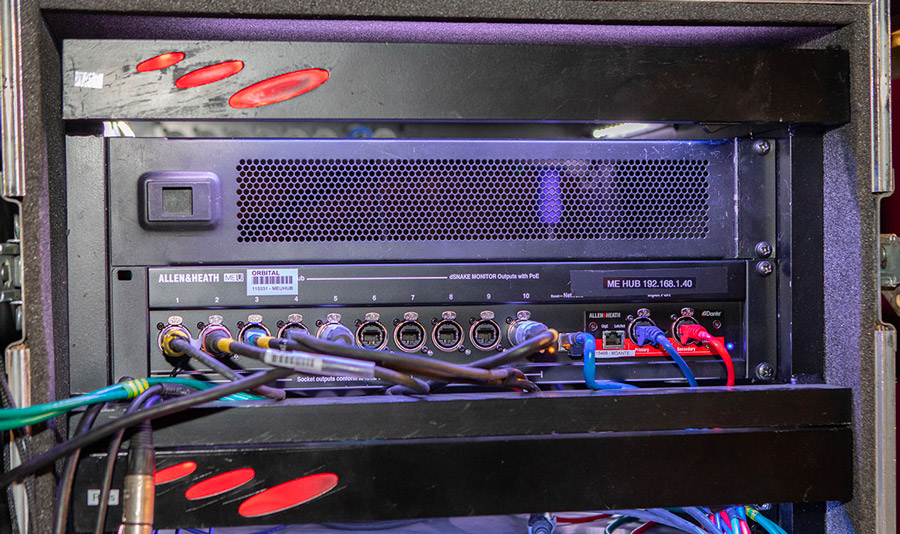
I had to find the routes, measure everything, and verify the use of certain existing equipment on site.
My touring experience made the task easier, especially with the English rental company Orbital, which is used to equipping West End venues without Speakon at the end of the cables because, generally speaking, London musicals have greater resources and stay on the bill longer!
We just had to unroll, plug in and go.
SLU : Did Orbital Sound also provide the intercom and video?
Xavier Marchand : Yes, they are the ultimate musical theatre specialists. They have everything you need to turn four walls and a thousand seats into a real Broadway theater. The only problem is that they wire everything to English standards, so you need to bring power adapters for the few things you may have forgotten or to charge your iPhones.
For the rest we have amps and other “big” equipment as spares, Orbital also has some in its warehouse or knows where to find what could fail and can act quickly. Finally we have done the same in France. We know where to find what we might need as soon as possible.
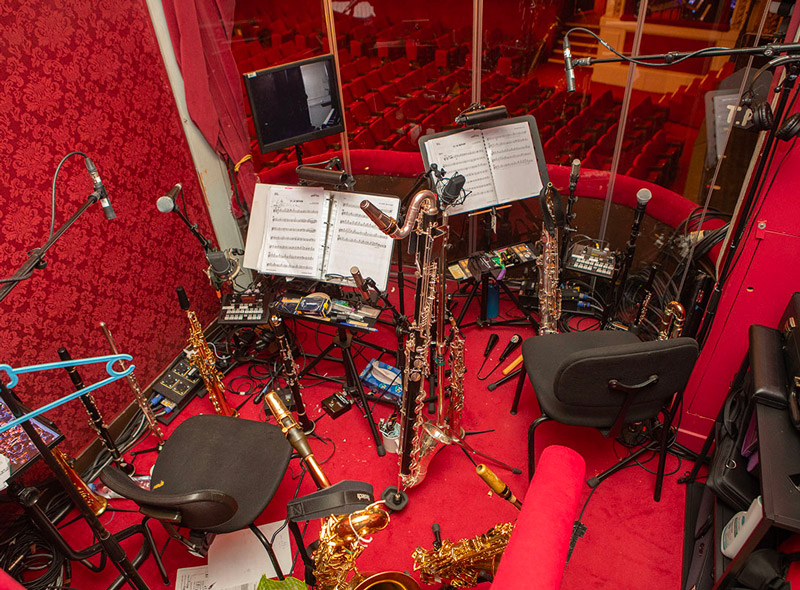
SLU : Have you tried to work with a French company?
Xavier Marchand : Yes of course. S-Group was consulted but they didn’t have the complete video package and especially video – the old fashioned way – with black&white screens with no latency and they would have had to buy the IR cameras, as well as the Allen & Heath ME. It would have been a lot.
Orbital’s know-how is also in the details, like the patch boxes with Harting connectors, which have four BNCs, six XLRs, mains and two RJ45s. You can send the monitors in one direction, the camera in the other, add an ambient microphone for the monitoring and provide power to the whole package.
Everything is in separate ground, it runs in AES/EBU with the intercom on the side. It works fast and well, even in case of a glitch. If you ask them for a Mac for QLab, for example, they deliver two in a standard rack, with two screens and two Dante switches.
For them, one computer is two computers and it’s the same price. Orbital splits the English musical theater market with Autograph and Sound System. These Companies were built by designers who could not find what they were looking for with the rental companies. If you want something done right, do it yourself (he smiles).
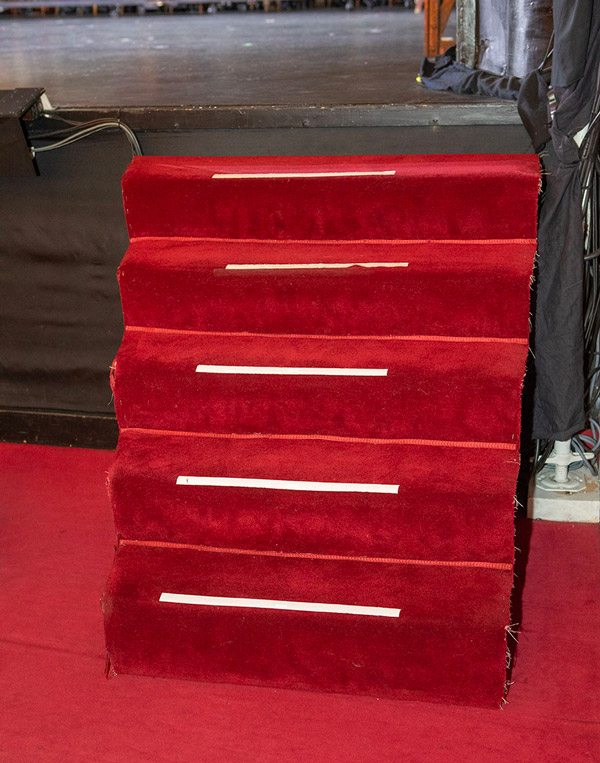
SLU : Does this musical have to have a particular color or tone to the sound?
Xavier Marchand : A little 60’s for some parts, with some tap dancing, so we don’t need a lot of low end or contour. The 60-120 Hz octave is not very full. We also had to trim the 160 Hz because of the room.
SLU : You had a certain artistic freedom to adapt and edit The Producers in French; how did you manage to find the right mix?
Xavier Marchand : There is a CD of the original version sung by Patrick Brady and Nathan Lane. We listened to it a lot and Julius researched the FX and tone. That’s why we have a rather simple and distant ribbon mics sound capture, not overly manipulated, to stay in the original style and a bit “old school”.
SLU : For the main audio system you supplemented the resident system at the Théâtre de Paris. Why the choice of Yamaha for the console?
Xavier Marchand : Julius had previously used a pair of CL5 consoles to get more outputs on Oliver Twist and we should have had a Rivage on another musical, which didn’t happen. So we went to see the gear with Delphine (Hannotin – ed. Note) – who is, by the way, an excellent resource – and we had a few visits from Yamaha to analyze our requirements and our feedback, because they are starting to make a name for themselves in the theater world.
This choice is also based on the “all in the box” aspect, which would be ideal if Les Producteurs goes on tour. The M7 reverbs (actually Y7, M still being exclusive to the 19″ rack version) are very, very good and so are the compressors. One option we had was the Allen & Heath, which is a nice console but a bit too geared towards live music applications, so the programming would have been too complicated.
SLU : What is your background, Xavier?
Xavier Marchand : I’m 33 years old. I graduated from the Lycée Kastler in Talence / Bordeaux in 2006 with a bachelor’s degree in Cinema and Audiovisual Studies. I spent two years working at the CFPTS (the Performing Arts Professional Technical Training Center), as well as in a company, becoming a sound engineer.
Once out of school, I started to work as an assistant system engineer, then I branched out to work as an assistant sound engineer for productions and festivals, with a strong focus on systems. I was trained on K1, K2 and Meyer, since I worked quite a bit with Dushow Bordeaux and other sound companies with a tendancy towards providing more and more complex solutions.
One night in 2014 I saw Cirque du Soleil’s Allegria at the Patinoire de Meriadeck and thought, “I want to do that”. It was tight, very good, and yet they had to downsize it to fit everything into what was, at the time, the only ‘large’ venue in Bordeaux.
I applied online to join Cirque du Soleil and was finally able to go in 2016, on a show called Amaluna, under a big top, which toured Europe. I toured for a year and a half in Europe, a year and a half in South America and a final year in North America.
SLU : You wanted to travel and learn?
Xavier Marchand : Learning, of course, and moving around a lot. I had the chance to go through three continents and to dozens of different cities. 950 shows… I have a taste for travel, heights, and rigging. I am a CPQ2-certified rope technician and a rescue rappeller. This allows me to help, to relate and, for example, to design rigs that are easier to hang (he smiles).
SLU : What was your position at Cirque?
Xavier Marchand : I started out as a technician and then as an assistant, which already meant some responsibility for purchasing and documentation. They were looking for someone familiar with the system to learn how to handle sound, but within the constraints of a circus, with its unusual timeline and show size.
The big top had 2500 seats, but we were touring with 89 semi trucks! Insane logistics. The set-up took five days. As we were crossing borders, we had to keep the equipment lists perfectly up to date by department and by location.
SLU : Did you get to touch any of the equipment?
Xavier Marchand : Of course everyone goes to the FoH and monitor consoles. There are three people on sound, who rotate roles. When you are hired, you have an average of three months of trial period, at the end of which you have to have learned the show, the front of house, the monitors and how to handle the stage well.
On top of that, you have to train the new guys, go into maintenance and learn how to fix what can be fixed by doing the small, day-to-day repairs, despite the fact that you start with 30% of spares. The show must go on and they make sure that each technician is fully operational on his own when he signs his contract.
The circus teaches you a lot about managing priorities, passing on information, training, administrative follow-up, pure technical aspects, maintenance, and, of course, mixing… and on top of all that, high quality standards. It’s a very comprehensive learning process and it gives you the tools to manage projects in a different way.
SLU : It came to an abrupt halt with Covid…
Xavier Marchand : Yes, with the layoffs and the American-style bankruptcy. It’s a pity because we were going to take Amaluna to Asia and I was probably going to be the head of sound.
SLU : And this is where we get to The Producers and Julius comes into the picture!
Xavier Marchand : We’ve known each other for ten years and when he knew I was back in France at the beginning of 2020, he asked me to come on board. I met the production team and I loved it. Michalik, the show itself, the location and the work to be done which, of course, was delayed for a year because of Covid.
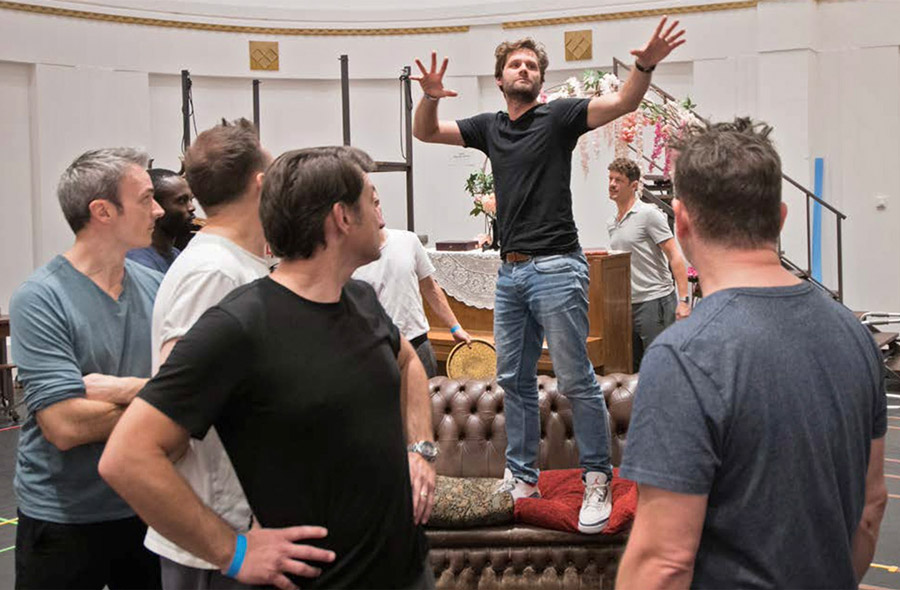
We had already worked with Julius at the Folies Bergère on another musical, and we established our collaboration very clearly with a true division of responsibilities.
He teaches me a lot of tricks and conveys a whole lot, while keeping a firm grasp on the requirements and the consistency in terms of delivering sound to the audience.
He is amazingly perceptive and discriminating, and I’m talking about 2 dB differences in the mix. He’s got a great ear and he’s a good consultant. While I was learning my mix, he went from seat to seat with his iPad to check it over and over again and get the best possible average.
SLU : Is this your first musical?
Xavier Marchand : With live musicians, yes. On the previous one in 2015 with Julius, we were working with a recorded orchestra. Here, we are really working English style with fewer musicians, but still musicians and good! And it was planned from the beginning that I would be at the console.
We are here in the foyer of the Théâtre de Paris to have a quiet chat with Xavier. After a quick change of batteries on the recorder, we welcome Julius Tessarech, the sound designer of Les Producteurs, who joins us.
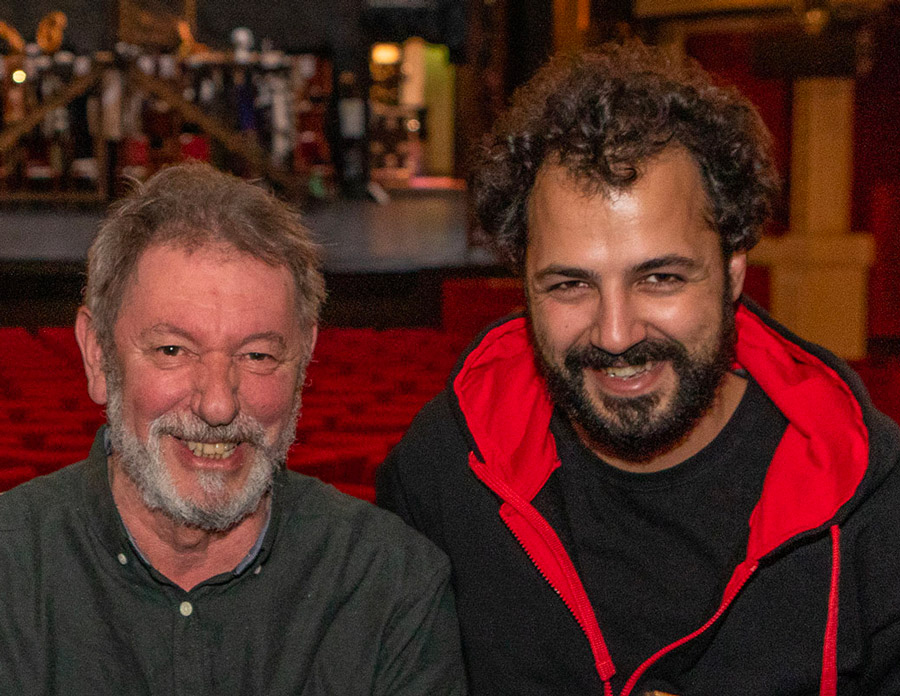
SLU : Still staying busy?
Julius Tessarech : Officially I am retired, but in reality, I am still working, but less (he laughs). As long as they still want me… Seriously, it’s a great musical, great team, great director, great theater, and the audience is definitely turning up.
I stopped working at the console, I could help out, if necessary, but it’s been a few years since I handed over the reins. It is necessary to leave space for the younger generations of technicians. Working on The Producers was a joy because I was able to help set up the show and then it goes on with its own life.
SLU : A question I often ask: how are your ears?
Julius Tessarech : (smiling) They are like those of a man of my age. I started out a little hard with rock bands, but was soon lucky enough and willing to move on. I sometimes have the conversation “…but that’s enough ?… Yeah, I assure you, it’s OK!” (he laughs)

SLU : What about the younger generation, then?
Julius Tessarech : I have always opened the door to trainees and beginners, especially back in the days when we didn’t have the tools and requirements of today, it went very fast.
SLU : Xavier ?
Julius Tessarech : I met him in Bordeaux during a festival and I was immediately impressed. The circus has further strengthened his organizational skills, but even when he was in charge of the stage, things ran perfectly.
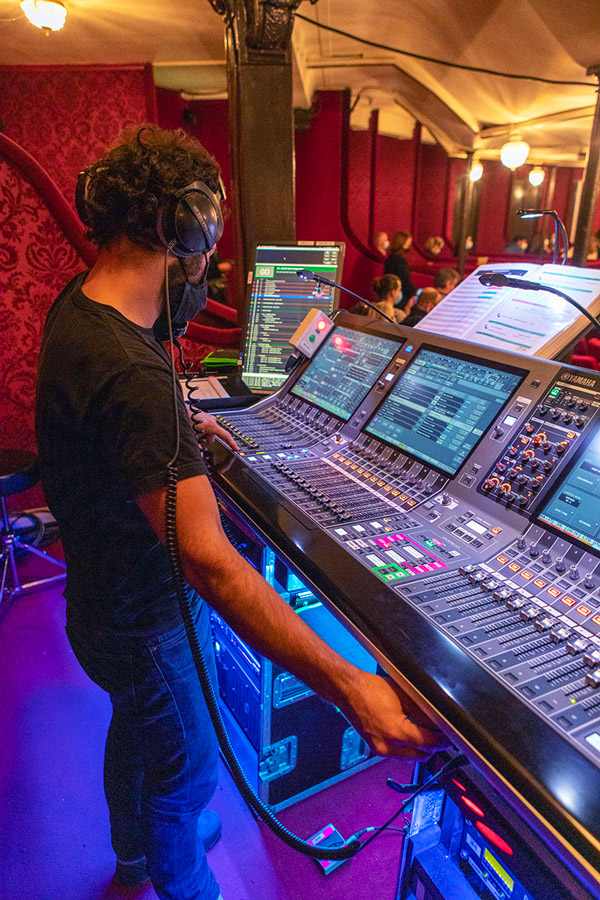
I then asked Xavier to come to Paris to handle the wireless and I quickly trained and put him at the console in order to teach him the key to the live mixing, where we fully accompany the artists on stage, and there again, he blew me away.
I called him after I started working on this musical and he very quickly handled the list of material for Orbital. They were amazed by his accuracy.
SLU : What about the mix?
Julius Tessarech : The same. He mixes and added a certain number of his own details or positions and it’s normal, it’s his mix. We worked together on the timbre of the voices and the levels and he makes the whole thing come alive.
During the preparation phase, he demonstrated a great memory and attention. Without taking notes, the next day I would find the few observations I had made the day before incorporated into the mix.
Working with someone like Xavier is very satisfying, without forgetting that he is in charge of training Pierre (Cottin – ed.) in mixing and that it goes well.
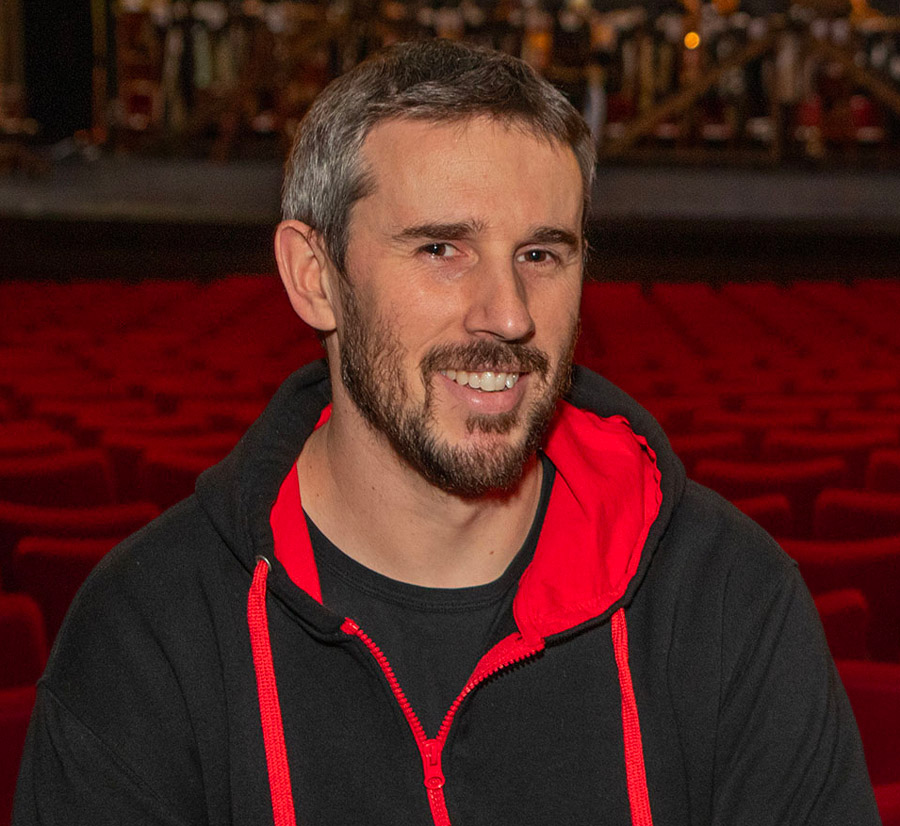
I also want to point out that on the stage, as well as for the musicians, it’s a blast. They play and they play well! It’s a nice show.
SLU : Once the show is up and running, your job is to guarantee its consistency over time?
Julius Tessarech : Sort of. Together with the people who are in charge of the staging and who do the same on their part, I try to keep the quality of the musical the same night after night, without deviating too much in terms of timbre, levels or FX.
I am demanding because I have a used eye and ear and, even when I am not on site, I listen to recordings of the shows. I am also fortunate enough to know the musical directors, musicians and almost all the performers on stage, and that’s a good thing. It helps!
SLU : How has the work gotten better since you started out?
Julius Tessarech : Lots of the equipment and the technology has come along way, but especially the consoles. What we have tonight, for example, is quite amazing. Beyond the mixing part, the number of things that are running in it in terms of effects and their quality is stupendous. And we are far from having used all its resources.
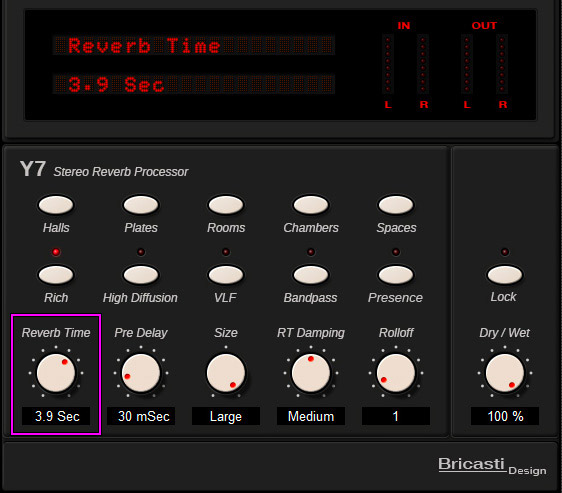
Take the Bricasti for example, it’s impossible to tell by ear that it’s not a real one. The Dante is very practical and reliable, wireless systems have also made enormous progress in terms of quality and channel density in a very limited spectrum, and finally the speakers, which offer SPL, coverage and response in a very small size.
SLU : So the console is satisfactory.
Julius Tessarech : Yes, and its Theater mode, too. The three screens and the flexibility of using the fader banks is very useful, because Xavier and I were able to work together, and the same goes for training, because you can work at the mixer with four hands. Unless you’re ultra-picky and want to have a Lexicon 480, with what it has on board, there’s plenty to work with. Even the Eventide H3000 emulation sounds great, and when it comes to working on certain groups, the Portico is very useful and efficient.
Xavier Marchand : The algorithms have changed a lot between the CL and the Rivage series. When you drop 3 dB on the channel EQ, it’s very noticeable, but we stayed with Rio and not Rpio; it’s too expensive and Orbital doesn’t provide them. My only criticism is that the time it takes to go from one scene to another is slower than on other consoles, but we’ve adapted.
SLU : How are you able to integrate a set up and a matrix as complex as that of a musical?
Julius Tessarech : That comes with experience. Today, we have computerized prediction and measurement tools that allow us to rough out the work before finalizing it little by little to obtain a sound that satisfies each audience member. To take the example of tuning a piano, it is the combination of the three strings that makes the note.
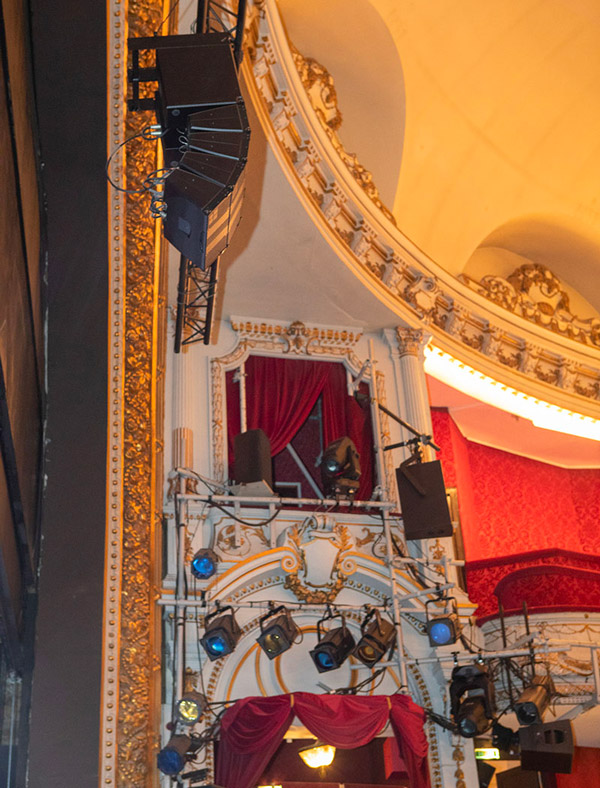
I learned a lot from Denis Pinchedez, a Dispatch big member and excellent mixer. The first time I pre-mixed the strings of a big symphony for him in a mobile hut, he came to me at the end of the sound check and said: “your violins are a little thin”.
I had taken them one by one and I had made the best sound possible, but the sum of the whole effectively produced a weak sound (he laughs). You just need to let them breathe with a low cut!
With the tuning it is the same. It is necessary to fine-tune, even if it means leaving an overly theoretical tuning of the 20 points of the sound reinforcement here, and then work on the matrices in order to achieve the best balance between the orchestra and the voices throughout the room.
For example, we need to compensate for the level of the central cluster as soon as we leave its coverage area, since it only amplifies the voices.
The PM5, which should technically be called the CS-R5 surface, is equipped with the DSP-R10 engine, not the most powerful one, as Xavier says, but more than enough to process 144 signals and to output them via 72 mixes, 36 matrices and two stereo outputs!
SLU : Do you end up paying for this complex set of matrixing, effects and buses in latency?
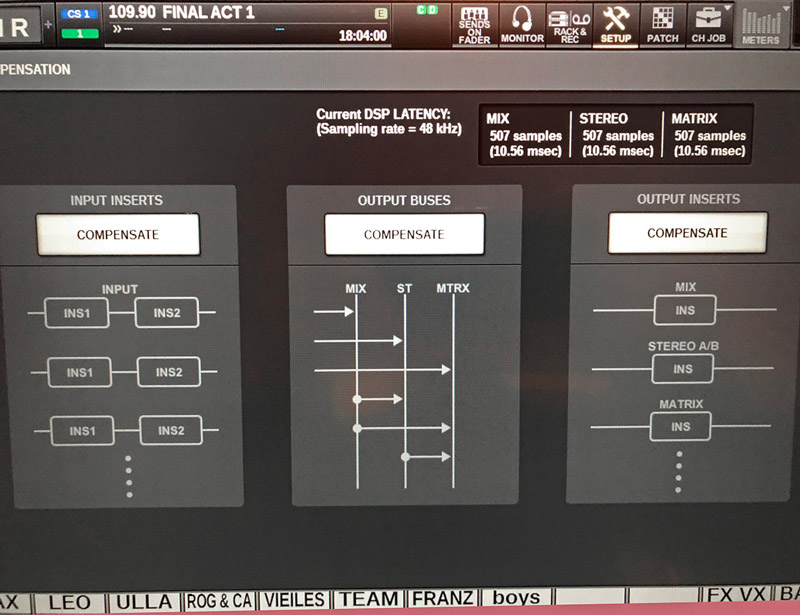
Xavier Marchand : Yes, we chose to compensate for this automatically on the console. Between Rio and outputs we have 10 milliseconds of latency, but we take advantage of what the stage brings in terms of the direct sound of the performers, and the size of the room.
When there are spoken passages, we limit the amplified sound to take advantage of the natural voices, but when the orchestra plays, we raise the level of the singing to rebalance the whole.
Julius Tessarech : We were even able to get back the few dB we were missing on a voice at the very end of a song by matrixing it in the rear ambiences, by putting a little bit of it into the reverb. And it works! (he laughs)
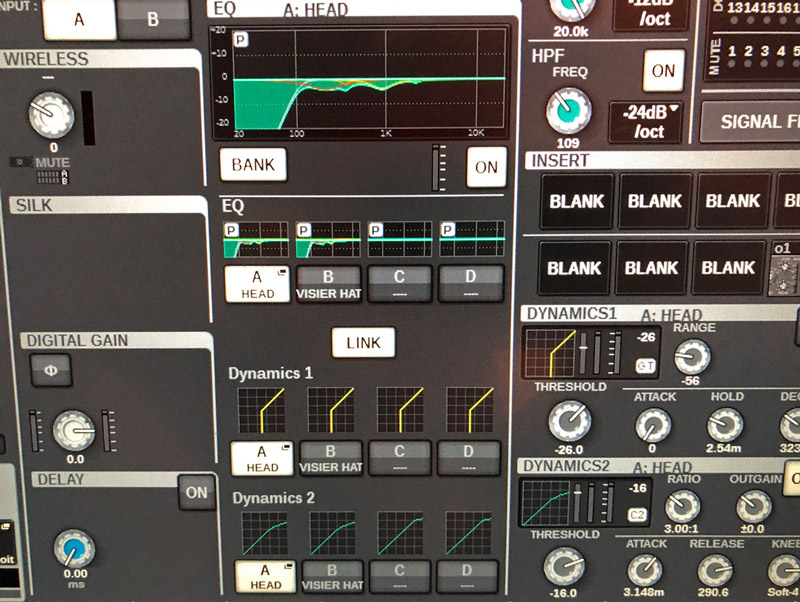
Xavier Marchand : We also made sure not to alter the dynamics and equalization of the voices too much.
We insert processing in order to properly convey the groups of men, women, music and All, but we leave the natural character and personality of each performer so that they are immediately recognizable.
Another advantage of the theater version of the software is that there are four different processing blocks per channel, which is useful for correcting the effect of a hat that might not always be on the character’s head.
The house lights go down
Right from the pre-show, the charm works and when the first notes of “King of Broadway” ring out, all the work of Julius and Xavier comes to life.
The sound is precise, well in phase, the ratio of music to voice is right and the tonal balance is nice, with a successful bass drum/double bass foundation and the sound of just seven musicians, very credible. A walk around the theater proves the value of the time spent by Julius to find the best compromise.
There are better seats than others, but the differences are still acceptable and the presence of a pair of subs in the balcony brings some real bottom end all the way up without degrading the sound on the parterre and the mezzanine. My compliments to Julius. The voices are very well reproduced so that you don’t miss any of Mel Brooks’ and sometimes Alexis Michalik’s jokes.
The adaptation is successful, as is the acting and versatility of the actors. Everything is there. Acting, singing, dancing, tap dancing, the latter well captured by the combination of floor mic, ankle mic and vocal mic. Also good are the sparse sound effects in surround, and they are done with the appropriate SPL.
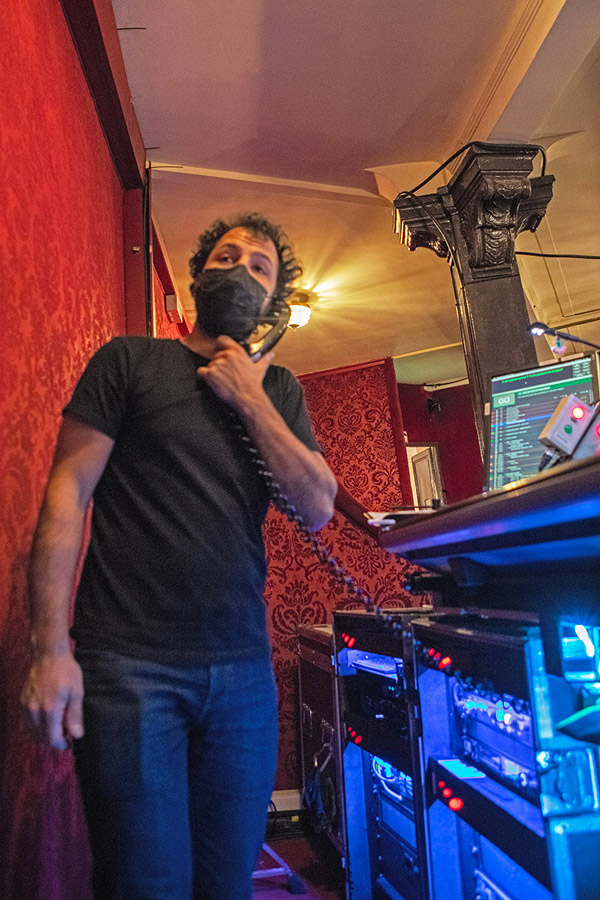
Our only criticism is that the two loudest opera boxes, where the brass and drums are both located at stage-left and equipped with plexiglass panels spill into the room. Perhaps it would be necessary to ask the musicians to hold back a little on the rare fortissimi, because it is not easy to mix under the mezzanine, where the sound arrives quite “pacified” by the velvet, while taking into account this occasional contribution of energy, which varies from one evening to another.
We can only dream of having a pair of good delays at the FoH to create a sonic cocoon. This would be expensive and take time to properly calibrate what lacks in color, dynamics and SPL in relation to the room, but would provide a real benefit to the sound engineer who would be able to more easily recognize and correct the normal deviations in this kind of show.
We can’t conclude without thanking the people who helped us to gather and condense this amount of information into this two-part feature, with a special mention to Xavier Marchand whose exhaustiveness is equalled only by his competence, but also to Julius Tessarech whose good ideas, technical choices and accuracy reflect years of fieldwork.
Xavier Marchand would like to thank: “Laurent Bentata, Eric Lousteau, Djamil Benali, François Soutenet, Jean-François Leclercq, Bruno Dabard, Delphine Hannotin, Dan Bailey and the Orbital Sound team, the staff of the Théâtre de Paris, the creative teams, the performers, the musicians and the technicians who have allowed us at every stage to put into practice and into action Julius’ brilliant design for the no less brilliant staging of Alexis Michalik”.
Nominated four times at the Molières 2022, Les Producteurs won two of them!
Trailer of The Producers :
More on the Theatre de Paris website



